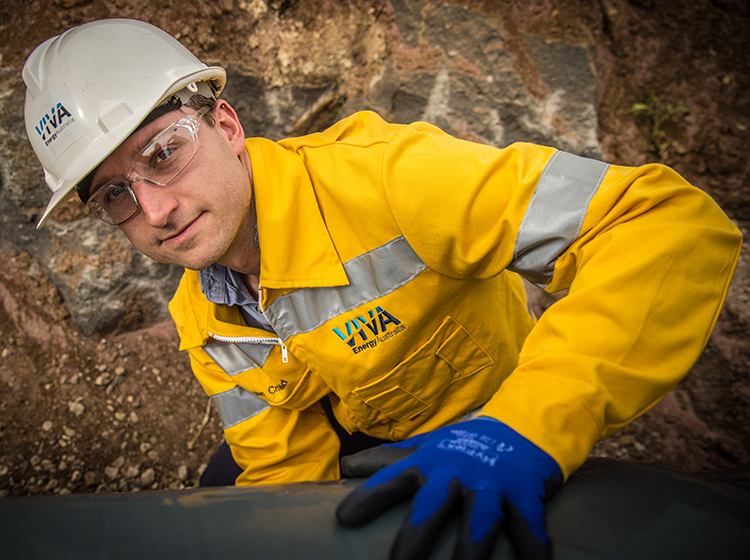Alan Creffield, Senior Reliability and Integrity Engineer at Viva Energy Australia, shares his thoughts on the charms, challenges and changes in the pipeline industry.
I got my start working for a pump manufacturer but I soon had my eye on oil and gas. The oil and gas industry was much more stringent when it came to requirements and design, and I could tell that people in that industry had a high level of competency.
I made the move to a valve manufacturer that supplied solely oil and gas clients. While there, I developed a close relationship with Viva Energy (then Shell Australia), designing all of the company’s control valves. When an opportunity arose at Shell in pipelines, I managed to get the job.
Pipelines have been much more challenging than I expected. Five years down the track, it’s still very challenging and rewarding.

Rising to the challenges
Among the real challenges we face is that whenever we go to maintain a section of our pipe, it’s always buried, so getting to it can be very expensive. We really need to be across our data and make sure we’re making an informed decision to excavate in a particular location.
Getting it wrong – because you dug in the wrong spot – can be costly and have other serious repercussions. Obviously, we have a multitude of processes to make sure that doesn’t happen. I enjoy that part – ensuring the accuracy of our tools and determining where to dig.
Fortunately, I really enjoy the technical challenges – pipelines are so much more complicated than a bit of steel in the ground.
Plus, I enjoy the collaboration, both internally (with other stakeholders and operations, for example) and externally (with regulators, the public and local councils).
Of course, the downside of collaboration is that things sometimes move more slowly than you’d like. But that’s understandable, given the number of moving parts and people to satisfy along the journey of repairing and maintaining pipelines.
Contributing to industry
For me, the challenges are about not just the difficulties, but also the rewards. For instance, I was accepted into the AS2885.3 standards committee last year. AS2885 is the overarching standard that applies to the pipeline industry in Australia.
It's been quite rewarding to join the industry’s best who sit on that committee and make a contribution. I do it on my own time – it’s not actually part of my job – but it’s good for Viva Energy, too, to have representation on the committee.
I’ve spent the last two years developing our integrity-management system, a suite of documents on how we manage the integrity of our pipeline. I've also produced a suite of maintenance documentation, which has enabled our maintenance team to deliver their work much more efficiently. Plus, we’re now getting a more consistent result in the field on how we want certain work done.
Pipeline industry innovation
Both Viva Energy and the pipeline industry as a whole are innovating. For example, we implemented the use of a 3D surface scanner about two years ago. It scans pipe and takes a profile of the surface, highlighting such factors as corrosion, dents and constructability.
These scans have enabled us to do much higher level, more accurate assessments. This has brought us significant efficiencies in the field – reduced time for assessments, reduced need for repairs and cost savings.
We’re also really starting to get involved in EMAT (electromagnetic acoustic transducer) technology. Within limitations, you can use EMAT to inspect sections of pipe without exposing them.
In the pipeline industry, you run a tool called an intelligent pig, which takes readings along the whole pipeline for anomalies like corrosion, cracks and dents.
Although the technology is becoming more expensive, the ability to detect these defects is cutting costs in the long term. You might be paying more for inspections, but you have to think of it as an investment in the future.
Piping up with predictions
Speaking of the future, I think the pipeline industry is facing a couple of new challenges. As assets continue to get older, the industry will require greater focus on integrity management and making sure maintenance is happening where it should. This may call for greater investment, whether that means re-coating or replacing pipe.
I also see residential and commercial developments in close vicinity of the pipeline as a challenge for the industry. Dwellings are moving ever closer to pipelines, which poses a potential risk. Pipeline operators want the public to be far away from the pipelines for their own safety.
If you’re keen to be part of this future, my advice is: learn as much as possible. There’s a lot to learn globally – the industry is not just insulated within Australia.
Also, spend as much time as you can in the field when maintenance is happening. There’s no better way to learn than by seeing the work firsthand.
Finally, surround yourself with knowledgeable industry people and learn all you can from them.
http://www.apga.org.au/issues/australian-standards/
Interested in Viva Energy’s products and services?
Find out more here